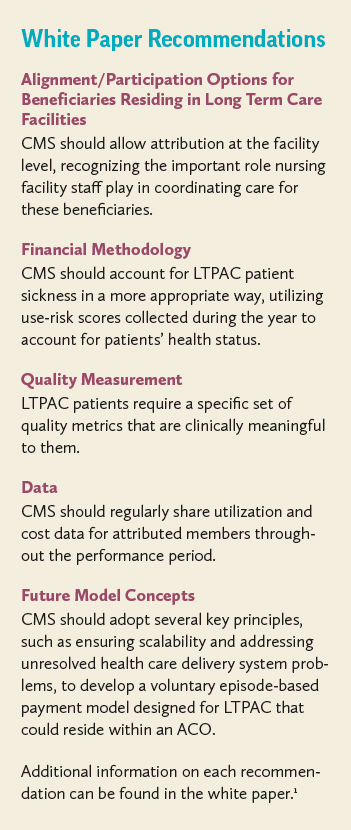Long Term and Post-Acute Care Providers in Value-Based Care
New recommendations aim to increase participation of long term and post-acute care providers in accountable care organizations.
Abby Barreto
6/1/2024
Population Health Management
 The American Health Care Association and National Center for Assisted Living (AHCA/NCAL) and the National Association of Accountable Care Organizations (NAACOS) have jointly released a set of recommendations1 that, if implemented, would help increase the participation of long term and post-acute care (LTPAC) providers in accountable care organizations (ACOs). The recommendations were shared with the Centers for Medicare & Medicaid Services (CMS) earlier in 2024.
The American Health Care Association and National Center for Assisted Living (AHCA/NCAL) and the National Association of Accountable Care Organizations (NAACOS) have jointly released a set of recommendations1 that, if implemented, would help increase the participation of long term and post-acute care (LTPAC) providers in accountable care organizations (ACOs). The recommendations were shared with the Centers for Medicare & Medicaid Services (CMS) earlier in 2024.
Fewer than 2,000 skilled nursing facilities (SNFs) participate in ACOs, representing less than 10 percent of SNFs nationwide, and nearly 70 percent of ACOs have no SNF participation. LTPAC providers face a myriad of challenges participating in CMS value-based care models, including ACOs, despite targeted partnerships’ ability to produce significant cost savings and care improvements.
Current program policies in ACO models do not align well with LTPAC providers, including those that determine which patients ACOs are accountable for, setting financial benchmarks, and quality measures. But, as one of the highest-cost and most complex patient populations, LTPAC presents a significant opportunity for improved resident outcomes and reduced costs to the Medicare program.
 AHCA/NCAL and NAACOS convened a roundtable of stakeholders in 2023 to address the challenges and, more specifically, develop recommendations for how LTPAC providers can more effectively participate in ACOs.
AHCA/NCAL and NAACOS convened a roundtable of stakeholders in 2023 to address the challenges and, more specifically, develop recommendations for how LTPAC providers can more effectively participate in ACOs.
“There is a tremendous opportunity for long term and post-acute care providers to lead the way with these value-based programs,” said Nisha Hammel, AHCA/NCAL vice president of population health management. “We gathered this group of thought leaders to determine how we can best support this shift to coordinated care and encourage CMS to further the value and role of these providers as effective partners.”
The paper focuses on two priority areas. First, how can existing risk-based arrangements, such as the ACO Realizing Equity, Access, and Community Health (REACH) Model2 and Medicare Shared Savings Program, be improved to increase SNF participation? Second, how can models better incorporate episodic-based payment within broader ACO arrangements?
Ultimately, the roundtable recommendations were focused within five key areas:
- alignment/participation options for beneficiaries residing in long term care facilities.
- financial methodology.
- quality measurement.
- data.
- future model concepts.
“If CMS is to achieve its goal of having all Medicare beneficiaries in an accountable care relationship by 2030, then it must take steps to better include provider types less represented in ACOs, including SNFs,” NAACOS senior vice president of government affairs Aisha Pittman said. “We hope our recommendations spark attention to this area, because patients served by LTPAC providers deserve the higher quality, lower cost care we know value-based care delivers.”
 AHCA/NCAL and NAACOS plan to continue collaboration on this effort to support a clear path forward in which ACO models better incorporate LTPAC providers.
AHCA/NCAL and NAACOS plan to continue collaboration on this effort to support a clear path forward in which ACO models better incorporate LTPAC providers.
References
1. https://www.ahcancal.org/Reimbursement/Documents/PHM/AHCA%20NAACOS%20White%20Paper_Final.pdf
2. https://www.cms.gov/priorities/innovation/innovation-models/aco-reach
Abigail Barreto is vice president of public affairs for the American Health Care Association/National Center for Assisted Living.